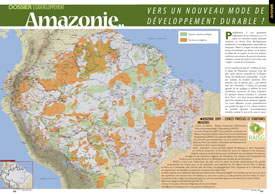The past few years have seen both the persistent exploitation of Amazonian resources, and several initiatives for an ecological and socially responsible form of development. Whilst the outcomes of these projects do not always live up to expectations given the enormous economic stakes in the region, they can nevertheless serve as examples worth pursuing further in an attempt to save this jungle which has become a victim of its own luxuriance.
The Amazon basin covers 7 million square kilometres and is one of the largest nature reserves on the planet. In addition to its remarkable biodiversity, it contains a wealth of raw materials (precious wood, water, gold, oil, gas, and so on) that attract unwelcome levels of interest, as does the agricultural potential of the 6 million square kilometres which were initially covered entirely by the rainforest. In just a few decades the “planet’s lungs” have been stripped of one fifth of their vegetation. The deforested land is used primarily for large ranches and the intensive production of economically profitable agricultural products such as soya and sugarcane.
Biodiversity under ever greater threat
The clearance of land is not limited to officially designated areas, and illegal deforestation is also sometimes carried out by migrants who, in their struggle to survive, are but little preoccupied by the impact of their farming practices on the soil. Thousands of plant and animal species have disappeared from the forests, in some cases even before they could be identified. The Amazonian ecosystems and populations who live there also suffer from the pollution and environmental damage caused by mining, oil and gas drilling, and the building of infrastructures for economic development (roads, bridges, hydroelectric dams, etc).
What other models might there be for the sustainable development of Amazonia? This was the question many indigenous delegations from Amazonia asked at the Social Forum held in late January 2009 in Belém (in the Brazilian State of Parà). They did not merely denounce the problems they were facing. By asking this question they also expressed their commitment to the socioeconomic and ecological future of their territories. Several experiments in development respecting both people and the environment also clearly illustrate their determination.
Acre and Amapá – model initiatives for agenda 21?
These two Brazilian States have set up programmes for the rational exploitation of their biodiversity. The programs are based on the principles underpinning Agenda 21* aiming at the preservation of natural areas and indigenous cultures. They are supported by the government and have received funding from international donor agencies.
Things are looking good for the home region of Chico Mendès.
Rio Branco, the capital of Acre, is run on participatory lines and is very active in sustainable development. It is guided in particular by the notion of “standing forest”, the rational exploitation of natural resources to secure the economic equilibrium of the region and encourage populations to remain there. Cooperatives harvest latex, rubber, acai berries (which have antioxidant properties), and Brazil nuts which are sold under fair trade schemes. In 2008 the World Bank granted a $120 million loan to support the Acre “Social and Economic Integration and Sustainable Development Project” (PROACRE) seeking to improve health and education services and develop economically profitable activities for the local populations.
But these promising perspectives should not lead us to overlook the various threats the region still faces. The rich oil and gas deposits in the valley of the Jurua are still highly coveted. Furthermore, it looks likely that intensive sugarcane cultivation for bioethanol* will continue to develop despite the September 2009 government bill banning this form of farming in Amazonia.
Amapá – temporary sustainability.
In 1994, when he was Governor of Amapá, Capiberibe launched a scheme to “preserve and promote biodiversity”. This was based largely on granting legal status to endangered zones to protect them from logging, gold-mining, and extensive ranching and thus ensure profitable and “sustainable’ activities for the populations. An inventory of exploitable resources was established and aid schemes put in place for harvesting, processing and developing new outlets for the products (honey, acai berries, Brazil nuts, and so on).
In parallel to this, a teaching programme based on the links between nature and society (Escola Bosque) was set up, guides were trained, eco-tourism infrastructure and facilities developed, and local police forces introduced so as to combat violence and pollution. The change of government in 2002 put an end to this community impetus. Teachers no longer received a special bonus for taking part in the Escola Bosque programme, and the local police no longer received any support. By 2008 it was being referred to by associations as Amapá’s ‘aborted project’.
The state of Rondônia, a classic example
The Brazilian State of Rondônia to the north of Bolivia was hard hit by logging and intensive ranching, and lost 50% of its forest in just a few years. In 1999 a group of about twenty peasants from Ouro Preto do Oeste set up an “Alternative Producers” association to develop sustainable forest agriculture based on harvesting and processing palm hearts, honey, and guarana. They were trained in environmental issues and micro-credit techniques, and received subsidies for processing, transporting, and distributing their products.
Before going bankrupt in 2008 the APA had 200 producer members and had established itself as one of the main social partners in the region. One of the reasons it went bankrupt was this increase in member numbers and associated costs, as Renata Mauro Freire, an agronomist at the University of Campinas, argues in her thesis: “there was a transfer of responsibilities, but without any support or monitoring of implementation management”. The study shows that the APA in Rondônia is far from being an isolated case. As in many associations the cohesion of the group was weakened once it grew in size. Cut off from its base, management was unable to cope with a reduction in resources.
Guarana, the treasure of the Satere Mawe.
The Satéré Mawé live in around a hundred or so villages scattered over 788,000 hectares in the valleys of the Marau, Andira, and Uaicurapa rivers in Brazil. They have always farmed guarana. In 1987 tribe representatives set up the CGTSM (Sateré Mawé General Council) to maintain their control over their cultural evolution and their environment. This led to programmes for replanting, protecting wild species, waste management, and the installation of solar panels. Guarana, which is appreciated around the world for its energising properties, became the main pillar of their development. The Satéré Mawé export it under various forms via fair trade organisations.
Ecotourism experiment in Venezuela.
In Venezuela in 1993, about twenty members of the native population set up the Organisation for the Indigenous Peoples of Amazonas (ORPIA). They started by assessing the impacts of tourism using social and environmental criteria such as water pollution, illegal wildlife trade, and recreational fishing and hunting. The first tourists arrived in 1998. Since then the organisation has continued to evolve and has published a guide for indigenous authorities wishing to set up ecotourism projects.
The Guiana Amazonian park.
This park in the south of Guiana is spread over 33,900 km2 and includes over 20,000 hectares under special protection. Opened in 2007, it is the largest national park in the European Union. 5,800 species of plants have been identified there, over 700 species of birds, 480 of fish (of which 192 are endemic), 186 of mammals, 261 of reptiles and amphibians, as well as hundreds of thousands of insects. The main threat facing this ecosystem is illegal gold mining. In 2009 a motion adopted by the Park’s Scientific Council called for “these criminal activities” damaging the health and safety of its inhabitants (about 8000 in all) to be combated as a matter of urgency.
Mixed results and lessons to be learnt
These various experiments in eco-development suggest possible solutions for safeguarding Amazonia. Lack of means, centralisation of power, increased numbers within a given body, the loosening of solidarity between the various actors, changes of government, and bans that are hard to enforce, burden those seeking to promote bio-development. Indeed, such obstacles actually give greater leeway to pressure groups working in favour of the intensive and destructive exploitation of Amazonia.
The indigenous populations are now heavily involved in programmes to protect Amazonia. According to Alain Ruellan, Emeritus Professor at the French National Higher School for Agronomy (École nationale supérieure agronomique) in Rennes and a specialist on Amazonia, what is needed is to “encourage diverse, dispersed occupation of the forest by human societies organised in small rural communities”, and to support and propagate modern scientific knowledge and common knowledge in order to foster “sustainable development”.
The link between indigenous and ecological issues was raised at the International Day of Solidarity with Amerindian Peoples held on 12 October. A few days earlier the President of the World Bank, Robert B. Zoellick, speaking about indigenous peoples in the run-up to the Copenhagen meetings, declared that “their long experience in the management of natural resources and in adapting to climate change can complement our knowledge of this complex question and help us to solve it”.
But sustainable and rational occupation is not something we can take for granted. It implies setting up the necessary social, economic, and technical conditions. The inhabitants of Amazonia need steadfast support and lasting outlets if the natural wealth is going to be a source of added value. The help of States, NGOs, and fair trade networks is thus very important.




 English
English Français
Français  Português
Português 









 Télécharger l'article en PDF est réservé aux abonnés Web !
Télécharger l'article en PDF est réservé aux abonnés Web ! 
 Pas de réaction
Pas de réaction Comment!
Comment!


 Voyages avec Tooy. Histoire, mémoire, imaginaire des Amériques noires : Editions Vents d’ailleurs, 2010
Voyages avec Tooy. Histoire, mémoire, imaginaire des Amériques noires : Editions Vents d’ailleurs, 2010
 Guyane. Produits du terroir et recettes traditionnelles. L’inventaire du patrimoine culinaire de la France : Editions Albin Michel, 1999
Guyane. Produits du terroir et recettes traditionnelles. L’inventaire du patrimoine culinaire de la France : Editions Albin Michel, 1999
 Alunawalé, un voyage à travers les milieux naturels de Guyane : Office National des Forêts, 2009
Alunawalé, un voyage à travers les milieux naturels de Guyane : Office National des Forêts, 2009
 Augusta Curiel, Fotografe in Suiriname 1904 – 1937 : Libri Misei Surinamensis, 2007
Augusta Curiel, Fotografe in Suiriname 1904 – 1937 : Libri Misei Surinamensis, 2007


